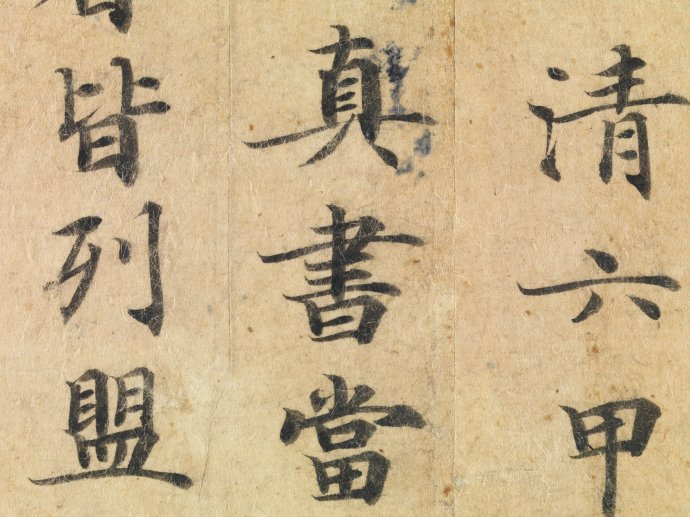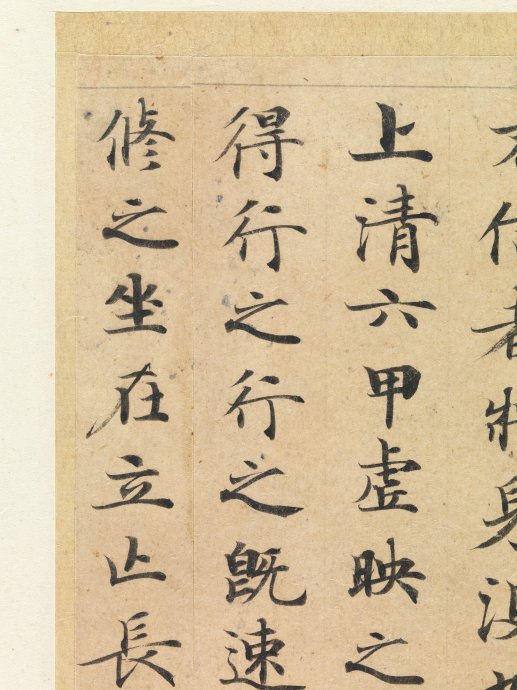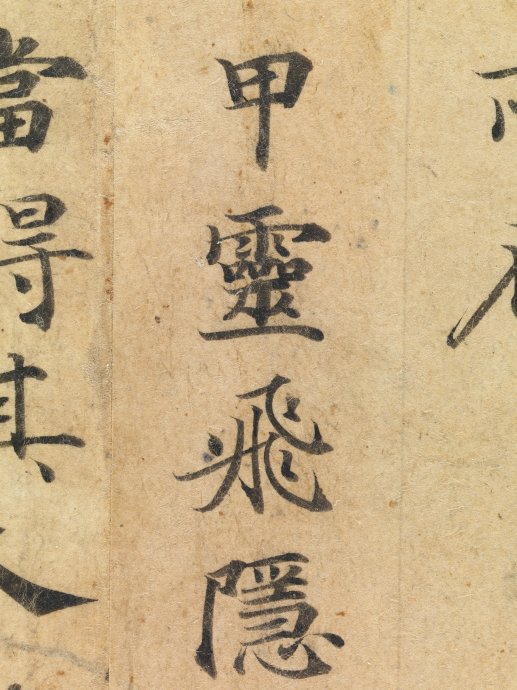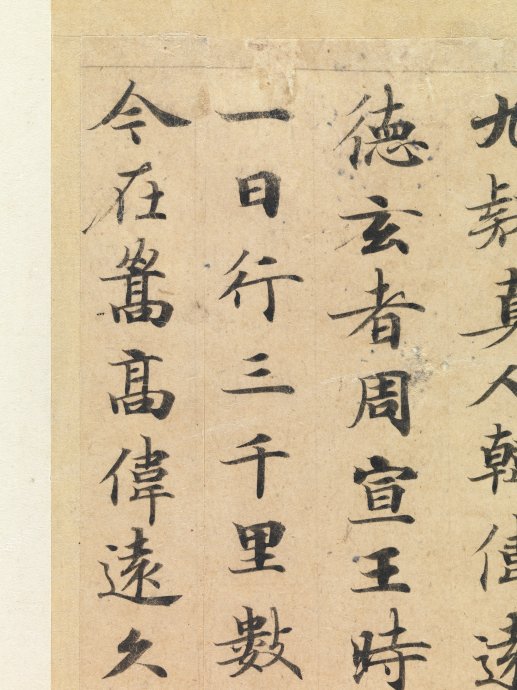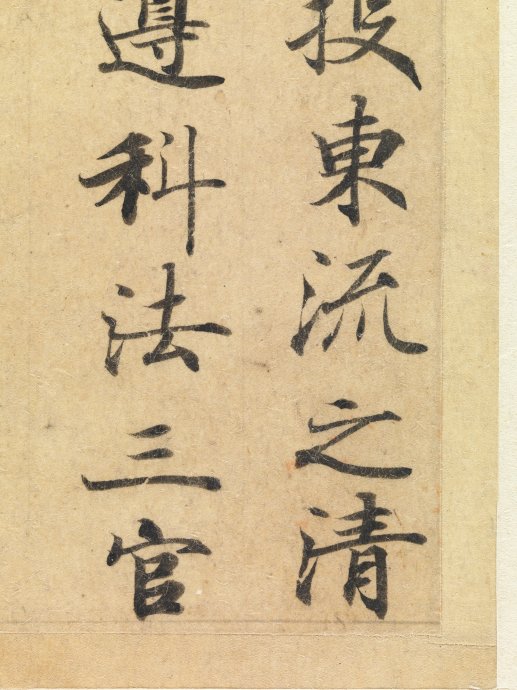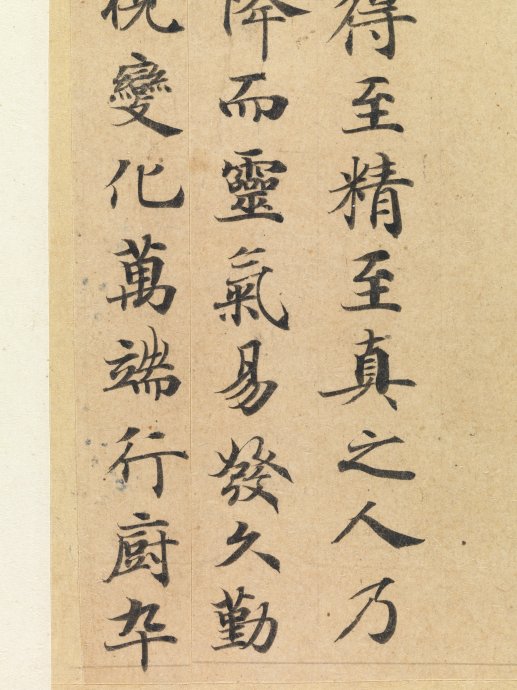The Past and Present Life of the Tang Dynasty's Small Regular Script "Ling Fei Jing"
Hu Dijun
The Tang Dynasty manuscript "Lingfei Jing" is a masterpiece in the history of Chinese calligraphy in regular script. Its full name is "Lingfei Liujia Jing". It is a Taoist scripture that mainly explains the method of contemplation. This post was written in the 26th year of Kaiyuan of the Tang Dynasty (738). There is no name of the person who wrote it, but the old legend is that it was written by Zhong Shaojing.
"Ling Fei Jing" is the pinnacle of the Tang Dynasty's small regular script. The writing used in this post is agile and light yet heavy, and the structure is charming and colorful yet dignified. It not only has the sophistication and proficiency common in sutra writing calligraphy, but also shows the calligraphy style of Er Wang "Ming Yue" everywhere. The elegance of "coming into your arms".
Before the scripture scrolls from the Mogao Grottoes in Dunhuang were unearthed, there were only a few Tang Dynasty scripture writing works handed down from generation to generation, and this scroll was considered to be the best among them. The clear and elegant calligraphy style was immediately astonishing to the world. He rose from a scholar to a famous regular script model in the Qing Dynasty. It was constantly reprinted and spread widely, even affecting the entire Qing Dynasty.
Even today, when we compare it with many Tang manuscripts unearthed from Mogao Grottoes and Tang manuscripts handed down from the Nara period in Japan, it is still not inferior, which shows the high level of calligraphy in this volume. However, there are still many controversies about the author, origin, circulation and dissemination of this volume of calligraphy in the past. This article attempts to brush away the dust of history and explore its true colors.
1. About the writer
The earliest record of the author of this volume is Yuan Jue of the Yuan Dynasty. In his book "Liu Jia Jing Inscribed on Princess Yuzhen of Tang Dynasty" in "Qing Rong Jushi Ji Volume 47", he believed that the post was written by Zhong Shaojing. The text is as follows:
One volume of "Lingfei Liujia Jing", written during the Kaiyuan period of the Tang Dynasty. The most famous people who could calligraphy at that time were Li Taihe and Xu Jihai. However, they all changed their styles and only favored the old method of King Shaojing. I have read the "Stele of the Governor of Aizhou" and "Huang Ting Jing", and there is no violation at all. During the Kaiyuan period, when he was demoted to the imperial court, all calligraphy and painting were produced by him. This volume is calm and upright, and it is known that it is not accessible to anyone who has not studied in the past, so it is undoubtedly identified as Shao Jing.
It can be seen from this that what Yuan Jue wrote about Zhong Shaojing is only a speculation and there is no reliable evidence. Later, Dong Qichang further confirmed this conclusion in the postscript of "Ling Fei Jing", which is as follows:
This volume contains the title of Huizong of the Song Dynasty and the small seals of Daguan, Zhenghe, and taboo words such as "泯" and "xie", which are all missing. Not only the word "Shimin" is already taboo, but all the classics written in the Kaiyuan period are imitated by Chu. In Henan, this unique Youjun "Huang Ting" was named by Yuan Qingrong as Zhong Shaojing. Song Siling also wrote that the classics produced by Song Siling were not included in the imperial palace, but the calligrapher's charm can be seen and heard. He also pointed out that the characters of Dingying seemed to be selected for submission. At that time, the night light caught the magpie, and the scraps were too much. I found this volume, which is like a man undressing his clothes. The book is written with great luck!
Zhong Shaojing's theory had a great influence. Most calligraphers in the Ming and Qing Dynasties said this. However, some scholars in the Qing Dynasty denied this theory. For example, Qian Yong in the "Collection" chapter of Volume 10 of "Lv Yuan Cong Hua" compared it with what was passed down at that time. Comparatively speaking, people in the Tang Dynasty believed that the scriptures were written by Jingsheng of the Tang Dynasty. The original text is as follows:
In the Tang Dynasty, there were only one or two Buddhist scriptures left in ink and sutras, most of which came from Nizi and Daoliu. The ancients called them scripture-derived books. Some of his books are as thin and strong as those of Ou and Chu, and some are as plump as those of Yan and Xu. His writing is strict and smooth, and from beginning to end, there is no flaw in his writing. This is beyond the reach of the people of the Song and Yuan Dynasties. It has been around for more than a thousand years since the Tang Dynasty. Although it is a classic book, it is still precious. In the past, Shen Qiyun of Yunjian asked Yuji to engrave in small regular scripts of the Jin and Tang Dynasties, and he collected seven or eight types of Tang sutras, one of which was called "Heart Sutra" (which Qiyun collected), and the other was called "Yu Shanyue Sutra" (which was collected by Shebao Xifen's family). Collected), one is called "The Sutra of the Wheel-turning King" (collected by Bao Dongfang, Fanchang), one is called "The Diamond Sutra" (collected by Lu Jinting of Wumen), one is called "The Sutra of the Longevity King Pinjana" (collected by Sun Xiaojiang, Ningbo), One is called the Mahaprajna Sutra (collected by Huang Xipu of Wumen), the other is the Lotus Sutra (collected by Xu Zhiting, Yangzhou), and the other is the Fragmentary Sutra in Hanyang Pagoda (collected by Zhang Xitang). He saw many things in his life, such as the Dousha Sutra (engraved by Ye family of Wumen) and the Vinaya Sutra (possessed by Wang Menglou). He understood the faults of the Lingfei Sutra. Zhong Shaojing's book is self-explanatory without arguing.
In addition, Wang Shu, a scholar of the Qing Dynasty, also believed that the "Lingfei Jing" was not written by Zhong Shaojing in his "Zhuyun Inscriptions and Postscripts".
So, who is Zhong Shaojing?
Zhong Shaojing, courtesy name Keda (AD 659-746), was a native of Qingde Township, Xingguo in the Tang Dynasty (now a native of Ganzhou, Jiangxi Province). During the Jinglong period of Emperor Ruizong of the Tang Dynasty, he was worshiped by Zhongshu Ling and granted the title of Duke of Yue. Calligrapher of Tang Dynasty. The calligrapher inherited Xue Ji's writing style, which is free and elegant. He is a book addict and a collector, with a personal collection of hundreds of volumes of original works by famous writers. The family has dozens of volumes of authentic works by Wang Xizhi, Wang Xianzhi and Chu Suiliang.
The reputation of Shao Jing's book is at its peak, and Mohists of all dynasties have praised it and rated it highly. Zeng Gong of the Song Dynasty said in "Yuanfeng Lei Manuscript": "Shaojing's calligraphy and painting are beautiful, follow the Tao and follow the law, and sincerity is the reason for this." Mifu's "History of Calligraphy" of the Song Dynasty praised Zhong Shaojing's calligraphy as "round and vigorous". Dong Qichang of the Ming Dynasty said: "Shao Jing's brushwork is exquisite, and the sharp edge is hidden in the wrist, which makes his son respect the spirit. Zhao Wenmin's writing is true to his ancestors." Bao Shichen of the Qing Dynasty said in "Yizhou Shuangji": "Shao Jing is like a new oriole. "The Voice of Hundreds of Turns", Ye Changchi of the Qing Dynasty highly praised it in "Yu Shi": "Shao Jing is as famous as Xue Shaobao, the first calligrapher in the early Kaiyuan Dynasty."
The works under Zhong Shaojing's name include "The Stele Yin of the Prince Shengxian", "The Sutra of the King of Wheels", "Ling Fei Sutra", etc., but among them the more reliable works are only the "Stele Yin of the Prince Shengxian" written by Wu Zetian. The names of the kings were inscribed on this stele. This stele is now stored on the top of Fengshan Mountain in Fudi, Yanshi County, Henan Province. The handwriting of the inscription is round and smooth, which is similar to the "Lingfei Sutra". It can be seen that there is a certain connection from the style of calligraphy. But there are two questions:
First of all, in the twenty-sixth year of Kaiyuan, Zhong Shaojing was already 80 years old. It is hard to believe that he could write such clear and precise regular script at such an advanced age.
Secondly, before the Tang Dynasty, due to the underdeveloped printing technology, the dissemination of books at that time basically relied on manual copying, which gave rise to a profession called "Jingsheng". At that time, most of the palace books were copied by Jingsheng at "Hongwen Hall" and other places. His status as a student is relatively humble, and it is incredible for Zhong Shaojing to engage in such a lowly job with the dignity of a high-ranking official.
It can be seen from this that the theory of Zhong Shaojing's book is definitely affiliated and unreliable.
During the Kaiyuan period, "Liu Dian of the Tang Dynasty" written by Zhang Jiuling and others recorded in Volume 10 that there were "eighty regular script writers" in the Secretary's Department, and in Volume 8 that there were "twenty-five regular script writers" in Hongwen Hall. Among the responsibilities of these "regular calligraphers" and "calligraphers", copying scriptures for the government is one of their tasks. So how were these government scribes trained? The Tang government once stipulated that "those who have a love for learning calligraphy and those who have a talent for learning calligraphy can enter the (Hongwen) library to study calligraphy."② The famous calligraphers Ouyang Xun and Yu Shinan once taught regular calligraphy. Those who are good calligraphers after completing their studies are assigned to various libraries to serve as calligraphers. These calligraphers have no official title and rank, and are equivalent to "minor staff" and are employed by the government. A small number of scriptures produced by Emperor Gaozong of the Tang Dynasty from Dunhuang and the scriptures handed down by the Imperial Household of the Tang Dynasty from the Heian Dynasty in Japan all have the words "Hongwen Guan regular script Cheng Gongdao", "Zuo Chunfang regular script Xiao Jing", "Secretary Province regular script Sun Xuanshuang", "Jingshuang regular script". The inscriptions of calligraphers such as "Jing Sheng Wang Siqian", "Jing Sheng Guo De", "Jing Sheng Zhao Xuanxiang", etc. It can be seen that the palace scriptures at that time were basically copied by these calligraphers.
Based on the above reasons, today's academic circles generally tend to believe that "Ling Fei Jing" was written by Tang Jingsheng.
2. About Princess Yuzhen
At the end of the volume of "Ling Fei Jing" there is the signature "Princess Yuzhen, a disciple of the Three Scenes of the Big Cave, was ordered to review and proofread the writing." Who is this Princess Yuzhen?
According to the records in "New Book of Tang: Emperors and Princesses": Princess Yuzhen was named Li Chiying, the tenth daughter of Emperor Ruizong of the Tang Dynasty Li Dan, and the sister of Emperor Xuanzong Li Longji. When she first came into the world, her mother Dou was killed by her grandmother Wu Zetian, who was in charge of the imperial power. She was raised by her aunt Princess Taiping since she was a child. Influenced by the Taoism worshiped by her father and aunt, she entered Taoism at the age of 20 and was awarded the title of Nu Guan. She was named Master of the Three Scenic Spots in Dadong, Xuandu City of the Qing Dynasty, and was granted the title of Staple Food Tax in Chongchang County.
Of course, as a princess, entering Taoism and cultivating the Taoism does not mean "just change your old clothes and makeup" and live a life under the green lights and yellow scrolls. Around 712, Tang Ruizhong (Yuzhen's father) established Taoist temples in Chang'an, Zhongnan Mountain, Luoyang and other places for the ordination of his two daughters (Princess Yuzhen and Princess Jinxian). At least three Taoist temples and an annex were built for Princess Yuzhen alone, and they also occupied the former residence of Princess Taiping, who was very prominent at that time. The splendor of her palace is not inferior to that of the imperial palace, or even more. At that time, some ministers complained that it was too extravagant.
At the same time, Princess Yuzhen traveled to famous mountains all over the world, making good friends with knowledgeable people, and had close contacts with some celebrities at that time. Some people even think that she often organized some literary salons in her palace, and she often recommended some works to her brother Xuanzong. Among the talented people she recommended to the court were poets Li Bai, Wang Wei, Gao Shi, etc. Li Bai and Wang Wei also wrote poems praising Princess Yuzhen:
The Immortal of Yuzhen often went to Taihua Peak. In the early morning, the sky drum is sounded, and the two dragons are soaring.
He keeps working on electricity, and there is no trace of his travels. When I enter the young chamber, the Queen Mother should meet.
——Li Bai's "Ci of the Immortal Yuzhen"
Outside the clear blue wind and mist, the road to Yaotai is open. How can I connect the Emperor's Garden with my own immortal family?
This place returns to Luanjia, and the edge of the stream turns to green flowers. The sun and moon are shining in the cave, and clouds are shining in the window.
There are soaring cranes in the courtyard, and Hancha trees flow up the stream. White jade grows in the fields, and cinnabar turns into clay stoves.
The valley is quiet and the springs are noisy; the mountains are deep and the sun is tilting easily. Royal soup and stone marrow, fragrant rice with flax.
The great road is endless, and eternal life has no limit. Looking up to the sky, there are five-cloud carriages coming and going.
——Wang Wei "Feng He Sheng made the work of Xing Yuzhen Princess Villa because of the title of Shibi Ten Rhymes"
In the early years of Tianbao, Princess Yuzhen was over fifty and began to plan her later life. She took a fancy to Wangwu Mountain, a famous Taoist mountain. Therefore, Emperor Xuanzong of the Tang Dynasty paid for her to build a large-scale construction project in Wangwu Mountain. The main building this time was called Lingdu Temple, which later became the final resting place of Princess Yuzhen. Regarding this, there is a clear record in Volume 28 of "Ming Yi Tong Zhi": "Lingdu Palace is located in Shangshu Valley, thirty miles west of Jiyuan County, where Princess Yuzhen of the Tang Dynasty was promoted to immortality. It was built between Tianbao and rebuilt between Yuan and Yuan Dynasties, and there is a stele. "The local historical records of Jiyuan also record that in her later years, Princess Yuzhen stayed at the Lingdu Temple in Yuyang Mountain in Wangwu. With the support of "Chaimen Pavilion and Bamboo Path Thatched Room", she became a monk and practiced Buddhism for 18 years. In the first year of Baoying (762) Year) ascended in the daytime at Xiangu Peak and was buried in front of Pingyang Cave Mansion.
In the Tang Dynasty, Taoism had a special status. In order to consolidate their rule, the Tang royal family claimed to be the descendants of Laozi Li Er, and the county officials were established in Longxi. In other words, they were also descendants of the flying general Li Guang of the Han Dynasty, and then passed on to the later founding emperor of Xiliang Kingdom, Li Gao. They were this One lineage. Therefore, Taoism is the religion of the Li family and the state religion. During the nearly Three hundred years of rule of the Tang Dynasty, Taoism was always supported and worshiped by the Tang Dynasty. Taoism basically ranked first among the three religions and received unprecedented respect. There were many Taoist temples in various places, and there were many Taoist disciples. The wind of Tao spread to emperors, nobles, and common people. Under this circumstance, it is not surprising that Princess Yuzhen believed in Taoism and became a Taoist priest.
Today we can see that most of the scriptures written in the inner palace of Emperor Gaozong of the Tang Dynasty were checked and proofread by government officials. However, this volume of "Lingfei Jing" was checked and supervised by Princess Yuzhen personally. It can be seen that this manuscript should be enshrined in the inner court of the Tang royal family. It is one of the Dao Zang Sutra volumes, which also shows how valuable this volume is.
3. The spread of ink marks on "Ling Fei Jing"
Mr. Qigong mentioned in his article "Recording the Forty-Three Lines of the Lingfei Sutra"③ that the "Lingfei Sutra" was discovered in the late Ming Dynasty. In fact, this work has already been famous because it was already in the Song Dynasty. It was hidden in the palace. Since only forty-three lines of this ink have been circulated today, we have no way to examine the original volume. However, Yuan Jue of the Yuan Dynasty and Dong Qichang of the Ming Dynasty both mentioned that this volume came from the Song Dynasty. Dong Qichang's postscript said: " This volume has the title of Emperor Huizong of the Song Dynasty and the small seals of Daguan, Zhenghe, etc." and "...the book written by Song Siling in Jingsheng is not included in the imperial palace." It can be seen that this volume has been in the imperial collection of the Northern Song Dynasty and the Southern Song Dynasty, and has the label of a personal letter of Emperor Huizong of the Song Dynasty . . The hiding place of the Yuan Dynasty is unknown, but its subsequent circulation was introduced in detail by Qian Yong of the Qing Dynasty in "Lv Yuan Cong Hua", which is recorded as follows:
In the winter of the thirty-fifth year of Wanli in the Ming Dynasty, Dong Siweng came to Wu Yongqing's house. Later Siweng wrote the "Lotus Sutra", which he must read and read, and it is as precious as a jade ball. At the age of Gengxu, Siweng published seven volumes of "Lotus" written by Taichang Qing, Chen Gong Zengcheng. Each volume was estimated to be worth a hundred gold. However, Yu Taichang was in trouble, so he supplemented it with a volume of "Lingfei". In the sixteenth year of Yue, Si Weng sent his son to come with gold to ask for the "Lotus" in a hurry, but the Chen family was in the process of cutting the stone, so it was inconvenient to suddenly turn around and go back and forth. Taichang's son, who was involved in politics in Huguang, was famous for his participation in politics, so he placed "Lingfei" on "Lianhua" to block his meaning. A private member who participated in politics cut off forty-three lines of "Ling Fei" and hid them at home, intending to use them as a public case about Lei Huan's sword, but Si Weng failed to examine it. At the age of Wuchen, he participated in politics and met Si Weng at Zhaoqing Temple in West Lake. He asked Ling Fei if he was okay.
From then on, the forty-three lines were hidden in the Chen family and passed down to Ti Zhai, where the prime minister used them and kept them for the rest of the world. Sikou Su, the Sikou of the Qinwei Classics in my hometown, heard about the name "Lingfei" and borrowed it from Zhongcheng, who was a student of Sikou. He had no choice but to give it to him as a gift. Once Sikou had obtained it, he kept it secret from others. After his death, his son, Taishi Jingxuan, was slightly praised in the world. When Zhongcheng was the governor of Anhui, he occasionally visited Xishan to make some money and return it. It was still owned by the Chen family, and there is a good story about Zhenyi Lin. Chen Wuxuan, an old friend of Yu's scholar, was recorded in "Yu Shang Bian" and described it in detail with Yu Bei. It is on fine linen paper and is very good. It has forty-three lines and six hundred and eighty-five words. Compared with other complete editions, it only has a few auspicious lights, but when compared with the stone edition, the writing is not smooth at all. As for the high energy and freedom of movement, it is beyond the reach of the stone edition. For the past few years, I have been running around for food and clothing, and I resented not seeing him. Later, when I saw Zeng's "Zi Huitang Tie", I realized that I had copied it from "Zang Zhen". Therefore, these twelve lines were also missing, and Zhao Songxue wrote a fake postscript at the back. , which is quite different from "Zang Zhen". I was in Hanshang in the winter of the year before last, and found out that it had been purchased by Wu Yushan Literature. Xie Junruonong, a member of the Shushe family, lent me the stone. I passed through Fengjing Town on the 20th day of the 10th month of the Xinwei reign of the Jiaqing Dynasty, and I first looked at the stone carvings in Ruonongzhai. I have been rubbing the stone carvings for decades and thirty years. I plan to visit Yushan again one day, and just imitate these twelve lines to make up for the shortcomings of the Chen and Zeng families. It would be a great pleasure!
From Dong Qichang's postscript and the above, we can know that Dong Qichang read this sutra in Xi'an in the 21st year of Wanli in the Ming Dynasty (1593), and wrote a comment at the end of the post. Fourteen years later, in the 35th year of Wanli (1607) Dong Qichang obtained this post from Wu Ting's family. Three years later, in the thirty-eighth year of Wanli (1610), Dong Qichang mortgaged it, together with the Lotus Sutra, to Chen Yong (character Yuanrui, name Zengcheng) of Haining, and redeemed it sixteen years later. The Chen family privately withheld forty-three lines of it. The forty-three lines of the Chen family were later handed down to the descendants Chen Yongfu⑥, who gave them to his teacher Qin Huitian⑦. After Qin Huitian's death, Chen Yongfu made money from his son, and then passed into the hands of Wu Yushan.
This post later spread, and Weng Tonghe's father, Weng Xincun, bought it in Yiwei (1839), the 18th year of Daoguang's reign, for 500 taels of silver. Since then, it has been passed down in the Weng family. Since Weng Tonghe had no heirs, his family collection was passed on to his brother Weng Tongjue and adopted by his son Weng Zenghan. In the subsequent inheritance, two more people had no heirs, so they inherited from the bloodline of Weng Tong and his other brother Weng Tongshu through adoptive children, and later passed into the hands of Weng Wange. Weng Wange was born in Shanghai in 1918. , received elementary and junior high school education in Tianjin. In 1938, Mr. Weng Wange went to study at Purdue University in the United States. In the autumn of 1948, in order to avoid the war, Weng Wange and his family packed up their family heirlooms and traveled across the ocean. It was first transported from Tianjin to Shanghai, then from Shanghai to New York, and arrived in the United States in early 1949. Weng Wange is now very old, and the forty-three lines of "Ling Fei Sutra" have been preserved by the Metropolitan Museum of Art in New York, USA, and were officially transferred to the Metropolitan Museum of Art at the beginning of the 21st century.
The remaining 43 lines of this sutra have been converted from volumes into albums, with a total of 10 pages and 43 lines. Attached to the sutra are three pages of letters from Dong Qichang to Chen Gu, as well as several inscriptions and postscripts from the Chen family and the Weng family.
As for the main part of Dong Qichang's collection, according to Qian Yong, two years after Dong Qichang redeemed the "Lingfei Sutra" from the Chen family, that is, in the first year of Chongzhen in the Ming Dynasty (1628), Chen Zhishen, the son of Chen Zhishen, and Dong Qichang met in Xihu Zhao When Qing Temple asked about the "Ling Fei Sutra", it had already been transferred from Dong Qichang's hands and disappeared. It is said that part of it was once hidden in the hands of Guo in Jiaxing. It is unknown whether it still exists in the world?
4. The spread of "Ling Fei Sutra"
Before the emergence of modern printing, there were two most effective ways of disseminating calligraphy works, one was stele engraving, and the other was engraving calligraphy. The dissemination of Lingfei Sutra began with "Bohai Hidden Genuine Calligraphy".
This post was privately engraved by Chen Wei in Haining, Zhejiang Province. It was carved in the third year of Chongzhen in the Ming Dynasty (1630). Chen Wei (ziyue Yuanrui, Fushen, Hao Xiyuan, Zengcheng) compiled it himself, and the title seal is copied by Yongle. stone. "Bohai Zhenzhen Tie" has a total of eight volumes. There is a list of Ties at the front. It is a collection of ten Dharma books from the Tang, Song and Yuan dynasties, compiled into 8 volumes. The first volume is "Lingfei Jing" written by Zhong Shaojing, the second volume is written by Chu Suiliang and Lu Jian, the third volume is written by Cai Xiang and Su Shi, the fourth volume is written by Cai Jing, Huang Tingjian and Mi Fu, and the fifth volume is written by Mi Fu and Mi Fu. Written by Youren and his son, volumes six to eight are written by Zhao Mengfu.
The word "Bohai" in "Bohai Zhenzhen Tie" comes from the ancestral home of the Chen family, Haining. The Chen family was originally the Gao family, originally from Bohai, after Gao Qiong, the Taiwei of the Song Dynasty. In the early Hongwu period of the Ming Dynasty, Gao Liang entered Chen Mingyi's family in the east of Ningcheng, Hainan, as his son-in-law. His son Rong then inherited his maternal surname as the Chen family, and took his father's Gao family's ancestral home as the county commander, so he was called the Bohai Chen family.
In the Ming Dynasty, the collection of collections of calligraphy became popular. The Chen family of Haining once carved 5 collections of calligraphy, including "Yuyantang Calligraphy" and "Bohai Zhenzhen Calligraphy", starting with "Yuyantang Calligraphy" and "Bohai Zhenzhen Calligraphy" as the last Excellent, this post is also the most widely circulated.
Although the "Bohai Zhenzhen Tie" was engraved in the third year of Chongzhen (1630), it is estimated that the first volume of "Lingfei Sutra" should have been engraved in 1626 before Dong Qichang redeemed the ink of "Lingfei Sutra" from Chen. Since it was directly obtained from Copied from the original work, coupled with the superb craftsmanship of the engraver, this engraved volume extremely accurately reproduces the style of the original "Ling Fei Sutra" and is praised by the world. Yang Shoujing's "Xue Shu Yi Yan" commented that "all the authentic calligraphy in the Bohai collection are ink on stone, among which the "Lingfei Sutra" is the most energetic and valued in the world."
However, for unknown reasons, the last 12 lines of the 43 lines of ink that Chen withheld were not engraved into the post. Since the "Bohai Zhenzhen Tie" version of the "Lingfei Sutra" was engraved before the original scroll was split, this inscription is the best engraved inscription that can best reflect the complete appearance of the original work.
The original calligraphy was carved with finely polished Taihu stones, which are fine and hard. The "Ling Fei Sutra" contains seven stone strips about 70 centimeters long and 30 centimeters high. Each strip is engraved with 5 pages and 6 lines per page. In addition to the calligraphy of "Ling Fei Jing" itself, there are also three paragraphs of Dong Qichang's postscript, totaling 5 and a half pages, totaling 35 pages in the book⑨. According to Mr. Zhang Yansheng's "Rare Books and Inscriptions", the original rubbing was intact. Later, the word "Zhu" in the first word of "Zhu Bing" in the third line of page 12 of the rubbing was cracked. In the early Qing Dynasty, the word "Zhaishi" in the second line of page 5 of the rubbing was If the word "Zhaishi" is damaged, the first extension is usually the word "Zhaishi" that is not damaged. According to Wang Zhuanghong's "Tie Xue Ju Yao": in the early Qing Dynasty rubbings of Dong Qichang's postscript, there are no straight cracks between the "Fifteen Years" line and the "Wuxu Winter" line; in the Qianjia rubbings, there are no random knife marks below the latter part of the text. There are 18 random knife marks on the lower part of the lower part of the rubbings made after Daoguang, which is known as the "Eighteen Knife Version". At that time, due to too many vertebral rubbings, the characters were blurred.
During the Taiping Heavenly Kingdom, due to the war, the "Bohai Zangzhen Tie" and "Yuyantang Tie" were seriously lost in the two halls. Some were used to build city walls. Later, the descendants of the Chen family collected and sorted them out and combined them into one frame. , it was renamed "Yan Hai Yu Zhen Tie" and moved to the old house of Chenge. At that time, there were still more than 300 yuan left. Later, after the Anti-Japanese War and the Cultural Revolution, the loss became even more serious. Until 1973, the cultural relics department organized efforts to collect the remaining stones of the Ertang Dharma Tie, and obtained more than 200 pieces. In 1982, the Haining County Government included the Ertang Dharma Tie in the first batch of county-level cultural heritage, and 7 pieces of "Lingfei Sutra" were among them. I don't know if the original stone is well preserved.
Later, as the "Ling Fei Sutra" became more and more popular, people began to use this elegant and graceful font as the standard model for the imperial examination. The demand from the society became greater and greater, and a large number of reprinted copies appeared. I have seen no less than ten types, some carved on stone and some carved on wood. Among them, one of the reprinted editions has even surpassed the original "Bohai Tibetan Zhen Tie" in reputation after the mid-Qing Dynasty. This The post is "Zi Hui" "Tang Tie".
"Zihuitang Tie", also known as "Zihuitang Calligraphy Treasures", was inscribed by Zeng Hengde of Jiaxiang in the 33rd year of Qianlong's reign in the Qing Dynasty (1768). Zeng Hengde was born in Jiaxiang, Shandong Province, and later moved to Hui'an County, Fujian Province. In the 17th year of Qianlong's reign, he was promoted from the assistant professor of the Imperial Academy to the director of the Ministry of Punishment, Wai Langzhong, and was named as the censor. In the spring of Xin Chou, he was awarded the title of magistrate of Yunyang, Hubei Province. The "Ling Fei Sutra" was engraved into the third volume of "Zi Huitang Calligraphy". During the re-engraving process, many modifications and forgeries were made to increase the value of the calligraphy. For example, the words "Da Guan", "Zheng He" and "Chu" were added at the beginning and end. Fake seals such as "Zhao Mengfu's" were forgedly added with Zhao Mengfu's inscription and postscript at the end of the post. The first word "from" on the fifth line of the original homepage was damaged in the upper right corner. In "The Genuine Post from Bohai Collection", a thin line is used to outline the original state of the damaged paper, while in "Zi Zi" In "Huitang Tie", the characters are directly filled in completely. Compared with the "Bohai Zhenzhen Tie", the handwriting of Zihuitang's "Lingfei Jing" is slightly fatter. This copy was enthusiastically sought after by the world in the middle and late Qing Dynasty.
According to friends, the descendants of the Zeng family could not keep this set of calligraphy stones. Soon, the original stone of "Zihuitang Tie" was purchased by Feng Yunhao, a wealthy businessman in Cixi, who took him back to his hometown in Cicheng and embedded it in his library - Zui Jing On the wall of the pavilion, during the Cultural Revolution, the Zui Jing Pavilion was demolished and the tiles were scattered. It was not until the end of the last century that Zhu Gui Temple was built in Cicheng, and the tile stones were collected again and embedded in the wall of Zhu Gui Temple.
In 2002, I traveled to Nanxun, Huzhou, and accidentally discovered part of the original stone of "Zihuitangtie" on the wall of Zhang Shiming's former residence. Among them, the original stone of "Lingfei Jing" was basically complete, but I don' t know when it was transported to Nanxun?
Another important engraving of "Lingfei Sutra" is "Wangyun Tower Collection", which was approved by Xie Gongming of Jiashan during the Jiaqing period and copied by Chen Rugang. Xie Gongming, courtesy name Shoushen and nickname Ruonong, was born in Fengjing, Jiashan, Zhejiang. He was a Jinshi scholar in the 52nd year of Qianlong's reign and a bibliophile. "Ling Fei Jing" was engraved in the first volume of this post, but it only has 43 lines. According to Qian Yong's records, the 43-line authentic copy of "Ling Fei Jing" was purchased by Wu Yushan at that time, and Xie Gongming lent the above stone. It can be seen that the 43 lines in "Wangyunlou Collection of Tie" are also copied from the original work.
Although this copy is no longer the complete picture, it is well-carved and better reflects the style of the original work.
In summary, it can be seen that the only inscriptions of the "Lingfei Sutra" that are truly copied from the original are "Bohai Zangzhen Tie" and "Wangyunlou Collection Tie".
During the Republic of China, most of the publications of "Lingfeijing" published in the Republic of China were "Zihuitang Tie", except for the initial rubbing of "Bohai Zhenzhen Tie" printed by Yiyuan Zhenshang Society in collotype. After liberation, the Cultural Relics Publishing House published the initial rubbing of the "Bohai Tibetan True Calligraphy" collected by Mr. Qi Gong (the word "Zhu" was damaged, but the word "Zhaishi" was not damaged), while the single edition of the "Lingfei Sutra " printed by the Shanghai Painting and Calligraphy Publishing House has always been This copy of "Zi Huitang Tie". There has been no news about the original work of Ling Feijing.
It was not until 1987 that Mr. Weng Wange from the United States published the 43 authentic copies of the "Ling Fei Sutra" in the 34th issue of "Yi Yuan Duo Ying" (January 1987) that the Chinese people could see the true face of Mount Lu and learn about the "Ling Fei Sutra" 》Authentic works have not died out.
5. The value of "Ling Fei Jing"
The scattered scrolls from the Dunhuang Scripture Cave have continued to flow into the market and have been auctioned at various auctions in recent years. The prices range from tens of thousands to hundreds of thousands or millions. Although it has been thousands of years, a total of more than 50,000 scriptures have been unearthed from the Cave. Most of the volumes were written by people in the Tang Dynasty. If things are not rare, why should they be expensive? I once discussed with netizens that if the 43 authentic copies of the "Ling Fei Sutra" were auctioned, the price would be far higher than these amounts. Both were written by people from the Tang Dynasty, so why is there such a huge gap in value? I think there are mainly three aspects:
1. "Ling Fei Jing", as a classic among handed down writings, has had an impact on the history of Chinese calligraphy, and its value cannot be compared with ordinary writings.
2. The calligraphy level of "Ling Fei Jing" basically represents the highest achievement of small regular script in the Tang Dynasty. However, among the Tang Dynasty writings in Dunhuang and the Tang writings passed down from the Heian Dynasty in Japan, there are not many excellent works. In terms of the overall calligraphy level It is not enough to overshadow the "Ling Fei Jing". Among the many Tang Dynasty scriptures unearthed in Dunhuang, there are only a few of the fifty or so that were written by Emperor Gaozong's inner palace, such as the Lotus Sutra and the Diamond Sutra. There are regular script masters in other places, but they still write in a very obvious sutra writing style, and rarely have the charm of calligraphers. There are very few sutra writing habits in "Lingfei Jing". We compare this post with "Lanting Preface" "Compared with "Zhiyong's Thousand-Character Essay", you will find that there are many similarities in the writing style and structure, and the style is close to that of Chu Suiliang . It is more influenced by the popular calligraphy style of the Tang Dynasty. It can be seen that the author may not be a professional businessman, but Probably a calligrapher. This is also the main reason why this volume of works was collected by the Song Dynasty court.
3. The "Lingfei Jing" can be believed to be a scripture enshrined by the royal family of the Tang Dynasty. This is essentially different in quality and grade from the works of folk scripture students and the scriptures issued by the government. Therefore, its value cannot be equal to that of other written scriptures.
It has been 1272 years since this volume of "Ling Fei Sutra" was written. At that time, after burning incense and bathing his hands, the unknown calligrapher respectfully and skillfully copied these words on thick white linen paper, maybe for livelihood, maybe for After completing the tasks assigned by his superiors, he must not have thought that one of them would luckily travel through more than a thousand years and influence the later world of calligraphy, allowing future generations to admire and admire it. If he were still alive If you know this, how surprised and proud you will be!
Note:
① Yuan Jue (1266-1327) was a scholar of the Yuan Dynasty. The courtesy name is Bo Chang and the name is Qing Rong Jushi. A native of Yin County, Qingyuan (now Ningbo, Zhejiang). He first learned from Dai Biao Yuan, and later studied under Wang Yinglin, where he became famous as a literary scholar. At the age of 20, he was elected as the headmaster of Lize Academy due to his outstanding talents. In the first year of Dade (1297), he was recommended as a reviewer of the Hanlin Academy of National History. During the Yanyou period (1314-1319), he moved to the service system and was appointed as a bachelor of Jixian University. Soon after, he was appointed as a bachelor of Hanlin University. In the first year of Zhizhi (1321), he moved to serve as a lecturer and participated in the compilation of the academic records of the imperial court. In the first year of Taiding (1324), he resigned. After his death, he was given the title of Dr. Zhongfeng, and participated in politics in Jiangsu and Zhejiang Provinces. He was granted the title of Duke of Chenliu County and was given the posthumous title of Wenqing.
②For details, see Volumes 8 and 10 of "Tang Liu Dian".
③For details of Qigong's "Forty-Three Lines of the Lingfei Jing", please see the 34th issue of "Yiyuan Duoying" (January 1987).
④Wu Ting, also known as Guoting, was named Yongqing and named Jiangcun. A native of She County, Anhui Province, he was a wealthy man in Xin'an at that time and a collector of calligraphy and painting in the Ming Dynasty.
⑤Chen Qi (year of birth and death unknown), was originally named Zukui, also given the courtesy name Yuanrui, also given the courtesy name Jichang, and his nickname was Zengcheng. Operator Chen Yujiaozi, calligrapher of Ming Dynasty. In the late Ming Dynasty , he was appointed as the Prime Minister of Guanglu Temple. He specializes in calligraphy, is liberal in erudition and loves ancient times. He is friendly with the famous calligrapher Dong Qichang and humbly consults him. Dong Qichang also regarded him as a confidant, thinking that he was "deep in calligraphy, good at all kinds of calligraphy, especially good at regular script". Chen paid attention to collecting fine calligraphy works from past dynasties throughout his life. Among the works handed down through his engravings are: "Bohai Tibetan Genuine Calligraphy" and "Yuyantang Collection of Ancient Calligraphy Calligraphy". Dong Qichang spoke highly of this: "Although the net has been collected for thousands of years, the appraisal and judgment are particularly refined", "This post is published, and the Linchi family has a total collection."
⑥Chen Yongfu (?-1799) was born in Haining, Zhejiang Province. He was elected in the 24th year of Qianlong's reign; he was a Jinshi in the 25th year of Qianlong's reign. He successively served as the director of the Examination Department of the Ministry of Civil Affairs, a member of the Ministry of Civil Affairs, and the magistrate of Yangzhou Prefecture in the south of the Yangtze River.
⑦ Qin Huitian (1702-1764) was a minister of the Ministry of Justice and a Confucian scholar in the Qing Dynasty. His courtesy name was Shufeng and his name was Wei Jing. He was a native of Wuxi, Jiangsu Province.
⑧Weng Xincun (1791-1862), named Erming, named Sui'an, and posthumously named Wenduan. A native of Changshu, Jiangsu Province, he was a Daoguang Jinshi, an official to the Ministry of Industry, and a bachelor. He has " Zhizhitang Poetry Collection". The father of Weng Tonghe.
Weng Tonghe (1830-1904) was born in Changshu, Jiangsu. Calligrapher of Qing Dynasty. His courtesy name is Shuping, his nickname is Songchan, and he is also known as Junzhai, Pingsheng, Songchan, Pinglu Jushi, Bingmei Jushi, etc. His nickname is Tianfang Xianren, and his late name is Ping'an Jushi. Jinshi in the sixth year of Xianfeng (1856). From official to co-organizer, he is a bachelor, minister of the Ministry of Household Affairs, and involved in mechanical affairs. During the Guangxu Revolution of 1898, he resigned from office and returned home. A famous politician and calligraphy artist in modern Chinese history. After his death, he was given the posthumous title Wengong. He has a thorough knowledge of Han and Song Dynasties, a literary master of Tongcheng, and a poem close to Jiangxi. The calligraphy is vigorous and the sky bones are open. He studied Ou and Chu when he was young, devoted himself to Yan Zhenqing in his middle age, and even went to Su and Mi. He is good at poetry and painting, and is especially famous for his calligraphy. In his later years, he became immersed in Han Li calligraphy and became the first calligrapher of Tong and Guang.
⑨The data comes from the measurement of the early Qing rubbings collected by the author, not from the original stone.
⑩This batch of scriptures is called the scriptures written by Emperor Gaozong's inner palace. They are the best scriptures written by the Tang people. They reappeared in the world with the discovery of the Dunhuang ruins. Most of their works were produced by Tang Hongwen Museum, Zuo Chunfang and other secretarial agencies. , most of the calligraphers were classics students, and the early supervisors were Yu Chang (son of Yu Shinan, a calligrapher in the early Tang Dynasty), and later Yan Xuandao (possibly a successor or close relative of the great Tang painter Yan Liben). Most of the writers and readers are disciples of Xuanzang of Tang Dynasty. The seriousness can be seen from the fact that the scriptures were used by the Tang royal family (emperors, harems, princes, and princesses) , and the writers of the scriptures should be the first-class masters in the capital at that time.
The forty-three lines of the "Ling Fei Sutra" are in the collection of the Metropolitan Museum of Art in the United States.
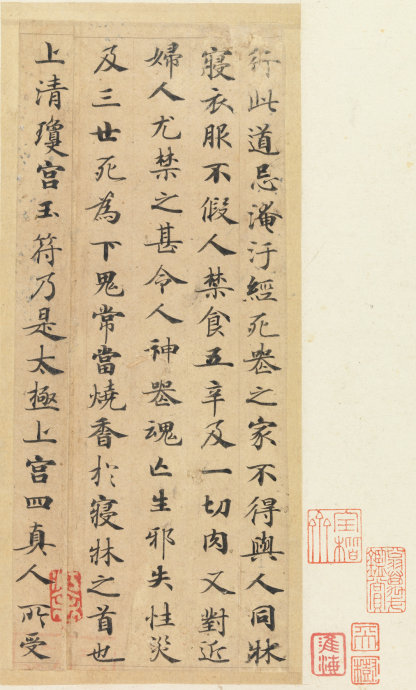
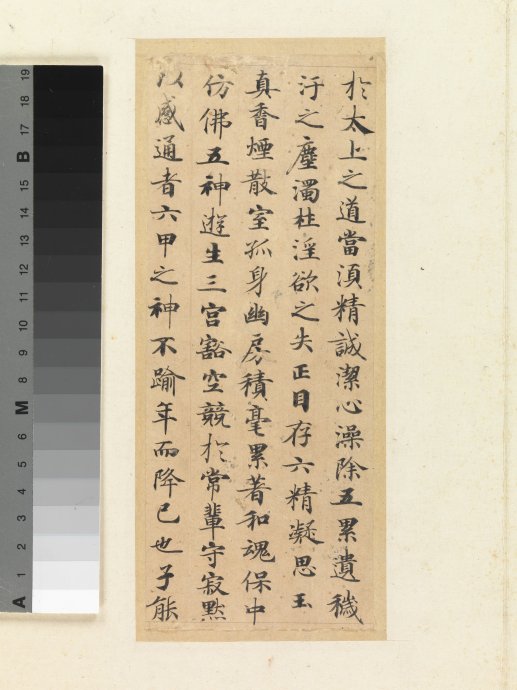
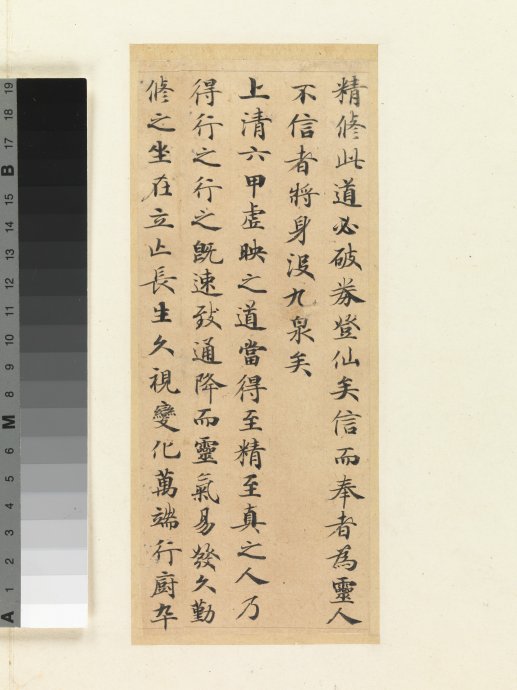
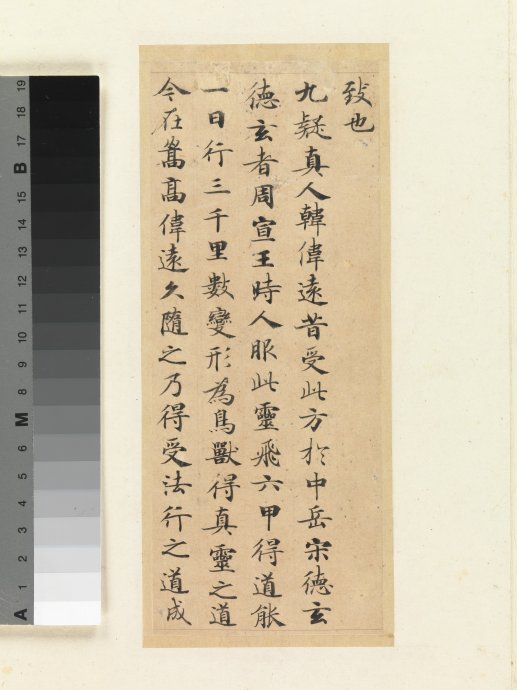
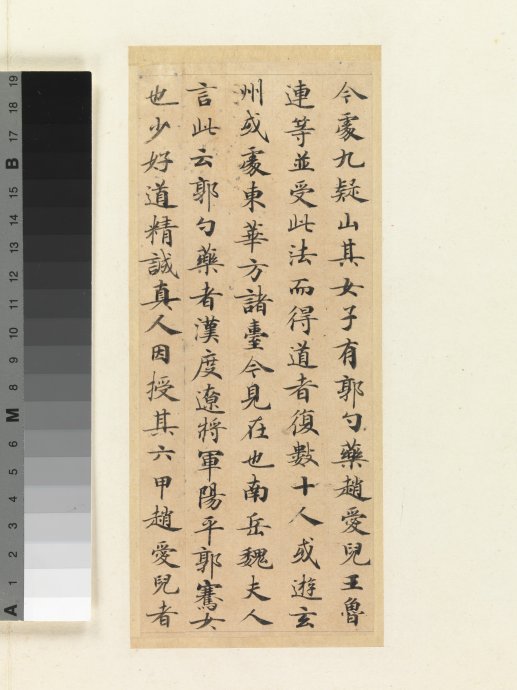
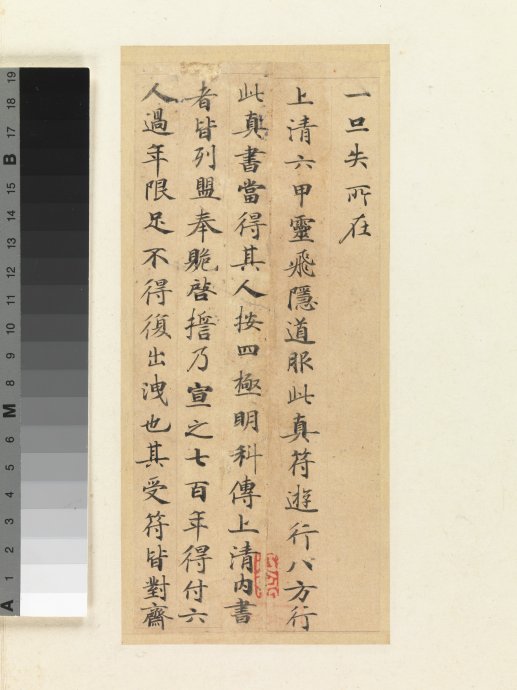
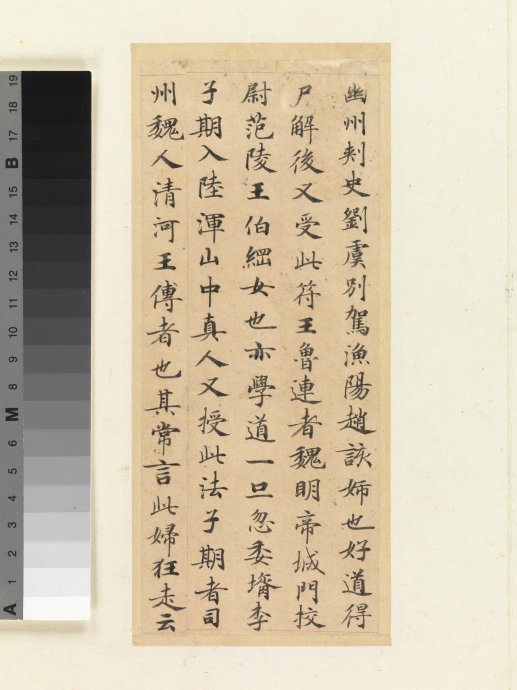
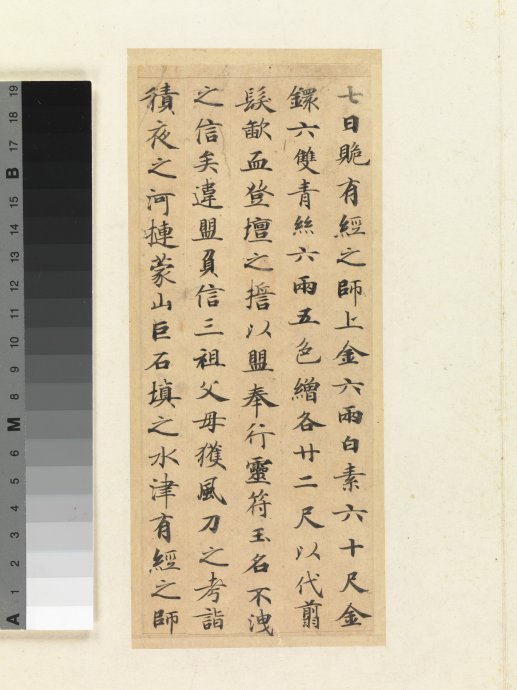
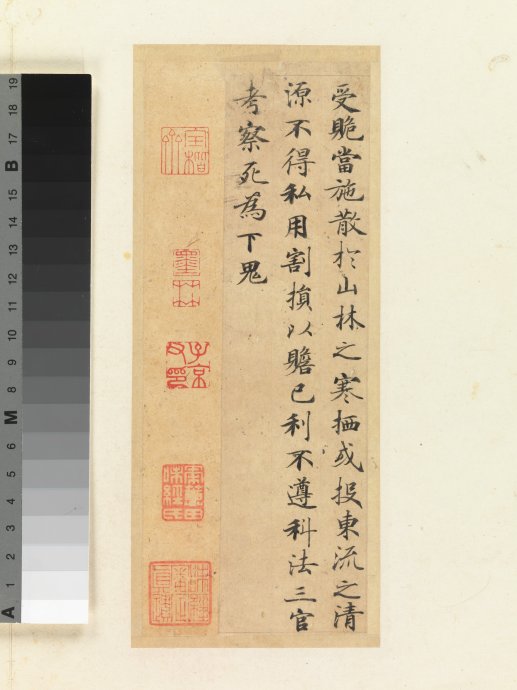
Partial enlargement:
